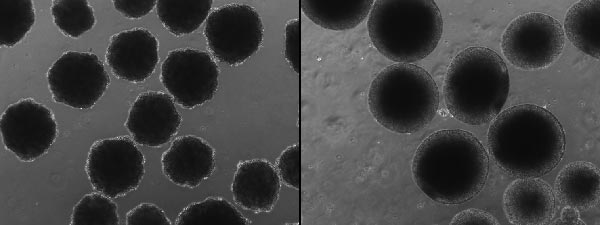
Neanderthal-ized brain organoids (left) look very different than modern human brain organoids (right) — they have a distinctly different shape, and differ in the way their cells proliferate and how their synapses form. Credit: UC San Diego Health Sciences
Novel study used brain organoids genetically modified to mimic now-extinct Neanderthals.
As a professor of pediatrics and cellular and molecular medicine at University of California San Diego School of Medicine, Alysson R. Muotri, PhD, has long studied how the brain develops and what goes wrong in neurological disorders. For almost as long, he has also been curious about the evolution of the human brain — what changed that makes us so different from preceding Neanderthals and Denisovans, our closest evolutionary relatives, now extinct?
Evolutionary studies rely heavily on two tools — genetics and fossil analysis — to explore how a species changes over time. But neither approach can reveal much about brain development and function because brains do not fossilize, Muotri said. There is no physical record to study.
So Muotri decided to try stem cells, a tool not often applied in evolutionary reconstructions. Stem cells, the self-renewing precursors of other cell types, can be used to build brain organoids — “mini brains” in a laboratory dish. Muotri and colleagues have pioneered the use of stem cells to compare humans to other primates, such as chimpanzees and bonobos, but until now a comparison with extinct species was not thought possible.
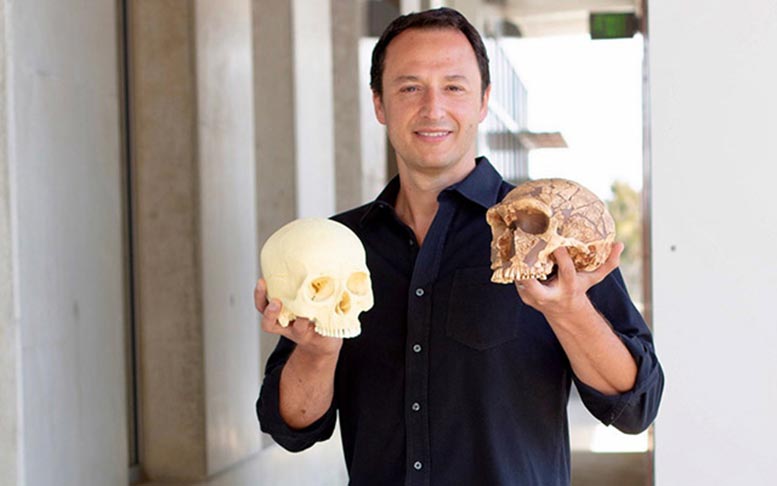
Alysson R. Muotri, PhD, is a professor at University of California San Diego School of Medicine. Credit: UC San Diego Health Sciences
In a study published on February 11, 2021, in Science, Muotri’s team cataloged the differences between the genomes of diverse modern human populations and the Neanderthals and Denisovans, who lived during the Pleistocene Epoch, approximately 2.6 million to 11,700 years ago. Mimicking an alteration they found in one gene, the researchers used stem cells to engineer “Neanderthal-ized” brain organoids.
“It’s fascinating to see that a single base-pair alteration in human DNA can change how the brain is wired,” said Muotri, senior author of the study and director of the UC San Diego Stem Cell Program and a member of the Sanford Consortium for Regenerative Medicine. “We don’t know exactly how and when in our evolutionary history that change occurred. But it seems to be significant, and could help explain some of our modern capabilities in social behavior, language, adaptation, creativity, and use of technology.”
The team initially found 61 genes that differed between modern humans and our extinct relatives. One of these altered genes — NOVA1 — caught Muotri’s attention because it’s a master gene regulator, influencing many other genes during early brain development. The researchers used CRISPR gene editing to engineer modern human stem cells with the Neanderthal-like mutation in NOVA1. Then they coaxed the stem cells into forming brain cells and ultimately Neanderthal-ized brain organoids.
Brain organoids are little clusters of brain cells formed by stem cells, but they aren’t exactly brains (for one, they lack connections to other organ systems, such as blood vessels). Yet organoids are useful models for studying genetics, disease development, and responses to infections and therapeutic drugs. Muotri’s team has even optimized the brain organoid-building process to achieve organized electrical oscillatory waves similar to those produced by the human brain.
The Neanderthal-ized brain organoids looked very different than modern human brain organoids, even to the naked eye. They had a distinctly different shape. Peering deeper, the team found that modern and Neanderthal-ized brain organoids also differ in the way their cells proliferate and how their synapses — the connections between neurons — form. Even the proteins involved in synapses differed. And electrical impulses displayed higher activity at earlier stages, but didn’t synchronize in networks in Neanderthal-ized brain organoids.
According to Muotri, the neural network changes in Neanderthal-ized brain organoids parallel the way newborn non-human primates acquire new abilities more rapidly than human newborns.
“This study focused on only one gene that differed between modern humans and our extinct relatives. Next, we want to take a look at the other 60 genes, and what happens when each, or a combination of two or more, are altered,” Muotri said.
“We’re looking forward to this new combination of stem cell biology, neuroscience, and paleogenomics. The ability to apply the comparative approach of modern humans to other extinct hominins, such as Neanderthals and Denisovans, using brain organoids carrying ancestral genetic variants is an entirely new field of study.”
To continue this work, Muotri has teamed up with Katerina Semendeferi, professor of anthropology at UC San Diego and study co-author, to co-direct the new UC San Diego Archealization Center, or ArchC.
“We will merge and integrate this amazing stem cell work with anatomic comparisons from several species and neurological conditions to create downstream hypotheses about brain function of our extinct relatives,” Semendeferi said. “This neuro-archealization approach will complement efforts to understand the mind of our ancestors and close relatives, like the Neanderthals.”
Reference: “Reintroduction of the archaic variant of NOVA1 in cortical organoids alters neurodevelopment” by Cleber A. Trujillo, Edward S. Rice, Nathan K. Schaefer, Isaac A. Chaim, Emily C. Wheeler, Assael A. Madrigal, Justin Buchanan, Sebastian Preissl, Allen Wang, Priscilla D. Negraes, Ryan A. Szeto, Roberto H. Herai, Alik Huseynov, Mariana S. A. Ferraz, Fernando S. Borges, Alexandre H. Kihara, Ashley Byrne, Maximillian Marin, Christopher Vollmers, Angela N. Brooks, Jonathan D. Lautz, Katerina Semendeferi, Beth Shapiro, Gene W. Yeo, Stephen E. P. Smith, Richard E. Green and Alysson R. Muotri, 12 February 2021, Science.
DOI: 10.1126/science.aax2537
Co-authors of the study include: Cleber A. Trujillo, Isaac A. Chaim, Emily C. Wheeler, Assael A. Madrigal, Justin Buchanan, Sebastian Preissl, Allen Wang, Priscilla D. Negraes, and Ryan Szeto, UC San Diego; Edward S. Rice, Nathan K. Schaefer, Ashley Byrne, Maximillian Marin, Christopher Vollmers, Angela N. Brooks, Richard E. Green, UC Santa Cruz; Roberto H. Herai, Pontifícia Universidade Católica do Paraná; Alik Huseynov, Imperial College London; Mariana S.A. Ferraz, Fernando da S. Borges, Alexandre H. Kihara, Universidade Federal do ABC; Jonathan D. Lautz, Stephen E.P. Smith, Seattle Children’s Research Institute and University of Washington; Beth Shapiro, UC Santa Cruz and Howard Hughes Medical Institute; and Gene W. Yeo, UC San Diego, Agency for Science, Technology and Research (Singapore) and National University of Singapore.
Funding for this research came, in part, from the Neanderthal Brain Foundation, National Institutes of Health (grants U19MH1073671, K12GM068524, K01AA026911), Brain and Behavior Research Foundation (NARSAD Independent Investigator Grant), National Science foundation (grant 1754451), Gordon and Betty Moore Foundation (grant GBMF3804), Coordenação de Aperfeiçoamento de Pessoal de Nível Superior (Capes, Brazil), FAPESP (São Paulo Research Foundation, grant 2017/26439-0), CNPq (Brazil’s National Council for Scientific and Technological Development, grants 431000/2016-6, 312047/2017-7) and Loulou Foundation.
Disclosure: Alysson R. Muotri is a co-founder and has an equity interest in TISMOO, a company dedicated to genetic analysis and brain organoid modeling focusing on therapeutic applications customized for autism spectrum disorder and other neurological disorders with genetic origins. The terms of this arrangement have been reviewed and approved by the University of California San Diego in accordance with its conflict of interest policies.


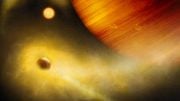


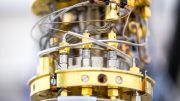
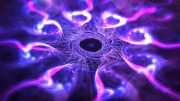
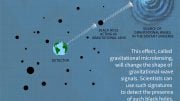

… I guess, that it will not be possible to know the real truth till the Neanderthals and the Denisovans are actually cloned, however that raises so much questions, after all…
… in the article, that can be found in this site>
https://scitechdaily.com/scientists-discover-gene-brain-size/
there is a interesting line:
“The researchers isolated different subpopulations of human brain stem cells and precisely identified, which genes are active in which cell type. In doing so, they noticed the gene ARHGAP11B: it is only found in humans and in our closest relatives, the Neanderthals and Denisova-Humans, but not in chimpanzees. This gene manages to trigger brain stem cells to form a bigger pool of stem cells. In that way, during brain development more neurons can arise and the cerebrum can expand. The cerebrum is responsible for cognitive functions like speaking and thinking.”
… I guess we will never know…
Ex-wife and her Mother carry Neanderthal Gene.. Body normal, BUT, Legs from Knees down are Short & looks weird…